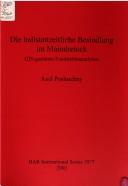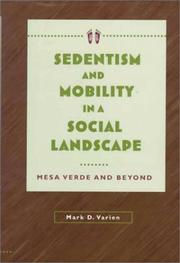| Listing 1 - 10 of 234 | << page >> |
Sort by
|
Book
Year: 1950 Publisher: Paris N. Boubée & Cie
Abstract | Keywords | Export | Availability | Bookmark
 Loading...
Loading...Choose an application
- Reference Manager
- EndNote
- RefWorks (Direct export to RefWorks)
Archéologie préhistorique ; Préhistoire ; Europe
Book
ISBN: 086054639X Year: 1989 Publisher: Oxford BAR
Abstract | Keywords | Export | Availability | Bookmark
 Loading...
Loading...Choose an application
- Reference Manager
- EndNote
- RefWorks (Direct export to RefWorks)
Land settlement patterns, Prehistoric --- Mounds --- Neolithic period

ISBN: 1841714569 Year: 2002 Publisher: Oxford : Archaeopress,
Abstract | Keywords | Export | Availability | Bookmark
 Loading...
Loading...Choose an application
- Reference Manager
- EndNote
- RefWorks (Direct export to RefWorks)
Book
ISBN: 1841718823 Year: 2005 Publisher: Oxford : Archaeopress,
Abstract | Keywords | Export | Availability | Bookmark
 Loading...
Loading...Choose an application
- Reference Manager
- EndNote
- RefWorks (Direct export to RefWorks)
Book
ISBN: 0826306918 Year: 1983 Publisher: Albuquerque University of New Mexico Press
Abstract | Keywords | Export | Availability | Bookmark
 Loading...
Loading...Choose an application
- Reference Manager
- EndNote
- RefWorks (Direct export to RefWorks)
Indians --- Land settlement patterns, Prehistoric --- Land settlement patterns, Prehistoric --- Antiquities --- Willey, Gordon R. --- Latin America --- Antiquities.
Book
ISBN: 0860544133 Year: 1987 Volume: vol 159 Publisher: Oxford : BAR,
Abstract | Keywords | Export | Availability | Bookmark
 Loading...
Loading...Choose an application
- Reference Manager
- EndNote
- RefWorks (Direct export to RefWorks)
Excavations (Archaeology) --- Land settlement patterns, Prehistoric --- Neolithic period --- Paleoecology
Book
ISBN: 0860542815 Year: 1984 Publisher: Oxford BAR
Abstract | Keywords | Export | Availability | Bookmark
 Loading...
Loading...Choose an application
- Reference Manager
- EndNote
- RefWorks (Direct export to RefWorks)
Britons. --- Bronze age --- Iron age --- Land settlement patterns, Prehistoric
Multi
ISBN: 129928177X 9088901260 9088900124 Year: 2008 Publisher: Leiden : Sidestone Press,
Abstract | Keywords | Export | Availability | Bookmark
 Loading...
Loading...Choose an application
- Reference Manager
- EndNote
- RefWorks (Direct export to RefWorks)
This publication contains the six main appendices to the PhD thesis ""A Living Landscape: Bronze Age settlement sites in the Dutch river area (c. 2000-800 BC)"" by Stijn Arnoldussen which was published by Sidestone Press in 2008. That study comprises an analysis of the nature (i.e. the constituent components) and dynamics (i.e. diachronic approaches to settlement dynamics) of the settlement sites. It aims to integrate and synthesize interpretations of Bronze Age settlements based on a number of large-scale excavations. The discussion of the archaeological and geological research on these sites
Excavations (Archaeology) --- Bronze age --- Land settlement patterns, Prehistoric --- Netherlands --- Antiquities.

ISBN: 0816548811 0816519048 Year: 2022 Publisher: University of Arizona Press
Abstract | Keywords | Export | Availability | Bookmark
 Loading...
Loading...Choose an application
- Reference Manager
- EndNote
- RefWorks (Direct export to RefWorks)
Research on hunting and gathering peoples has given anthropologists a long-standing conceptual framework of sedentism and mobility based on seasonality and ecological constraints. This work challenges that position by arguing that mobility is a socially negotiated activity and that neither mobility nor sedentism can be understood outside of its social context. Drawing on research in the Mesa Verde region that focuses on communities and households, Mark Varien expands the social, spatial, and temporal scales of archaeological analysis to propose a new model for population movement. Rather than viewing sedentism and mobility as opposing concepts, he demonstrates that they were separate strategies that were simultaneously employed. Households moved relatively frequently--every one or two generations--but communities persisted in the same location for much longer. Varien shows that individuals and households negotiated their movements in a social landscape structured by these permanent communities. Varien's research clearly demonstrates the need to view agriculturalists from a perspective that differs from the hunter-gatherer model. This innovative study shows why current explanations for site abandonment cannot by themselves account for residential mobility and offers valuable insights into the archaeology of small-scale agriculture.
Book
ISBN: 8760135700 Year: 1993 Publisher: København : Miljøministeriet. Skov- og naturstyrelsen,
Abstract | Keywords | Export | Availability | Bookmark
 Loading...
Loading...Choose an application
- Reference Manager
- EndNote
- RefWorks (Direct export to RefWorks)
Land settlement patterns, Prehistoric --- Mesolithic period --- Underwater archaeology
| Listing 1 - 10 of 234 | << page >> |
Sort by
|

 Search
Search Feedback
Feedback About UniCat
About UniCat  Help
Help News
News